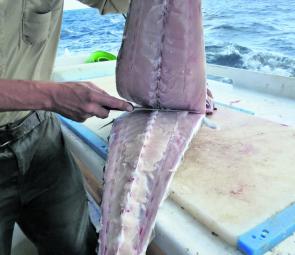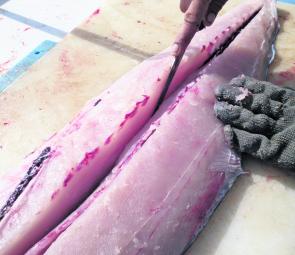Last month we looked at how to preserve a catch by immediately spiking, bleeding and chilling the fish. This month we will examine how to fillet it.
There are many differing opinions on how best to fillet a fish. This is just one way to fillet a long slender fish, such as a Spanish mackerel. We don’t use the traditional ‘one side at a time’ sequence. This is different enough to attract the attention of onlookers.
1. Start the first cut up at the head end of the fillet. Then move to the other end the tail. and start the other end of the cut.
2. Work along the full dorsal length of the top fillet; from one end to the other. Insert the knife no further through than the start of the nodules along the centre of the backbone.
3. Then start on the underside fillet and continue all the way along the frame. You should have cuts along both sides of the top dorsal. of the mackerel’s frame.
4. Next start on the belly side of the fillets at the tail in this case. and continue with the knife along the underside. Once the first underside cut is finished from end to end, then go along it again to deepen the cut and separate more flesh from the backbone.
5. Working from the tail, run the fillet knife along the mackerel’s backbone.
6. To remove the fillet you will have to lift the fillet and ‘wiggle’ the edge of the knife up and over each of the nodules along the centreline of the spine. Some anglers prefer not to lift the fillet – they do it by feel, with the fillet remaining flat – their rationale is that lifting the fillet causes it to flex, which breaks some of the flesh’s connectivity firmness.. Do the same to the second fillet on the other side to remove it.
To break down the fillets into freezer sized pieces:
7. Cut down either side of the centreline ‘part’ in order to commence the removal of the bloodline and pin bones. This will create two half fillets.
8. Then cut all the way through to separate the two half fillets and remove the line of pin bones down the centre..
9a. and b. Trim out the rib bones (left) and cut out the blood line, which is not particularly good eating but makes a good berley.
10. Cut the long fillets into shorter blocks/slabs and they are then ready for vacuum sealing for the freezer.
Facts
Precision Pak fish chiller bag
The beauty of the heavy-duty Precision Pak Fish Storage bag is that it is easily stowed out of the way and doesn’t rigidly take up the space of a long esky. It is especially ideal for small boat trollers or live baiters and 4WD-based beach/rock anglers.
The 170cm size of the large PP Fish Storage is perfect for big mackerel and mulloway; the smaller bag is just over 140cm long and is great for snapper and school mackerel.
The easy cleaning lined-bags are made of UV protected nylon and thick insulated foam with very useful carry straps. These bags are de rigueur in the international professional tournament scene and are distributed in Australia by Wilson Fishing.













